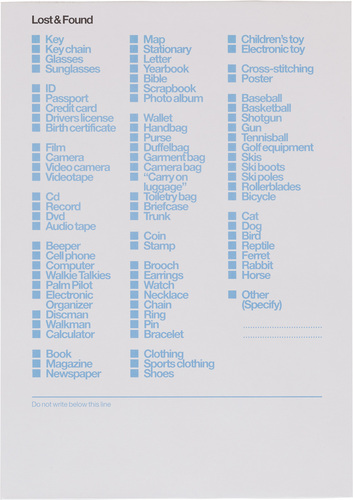Its formula remained almost unchanged over the years: the editorial team spurs people in their network on to unearth the tapes, cdroms, films, videos or slides which are close to their heart but always seemed out of place or never even found a stage.This debris, veering between art and pulp, is than shown in the context of a Lost & Found evening. These have proved to be unique compositions.
Impromptu
Trying to capture the quality of Lost & Found is already a form of damaging
the atmosphere of the event. For the magic is in its highly impromptu character; the programme is never made public and the announcement of the evening is posted only a couple of days before the event. Still this invariably is enough to make up for a cheerful and committed audience, queueing impatiently at the door of the Waag's Theatrum Anatomicum. Only ninety people are allowed in, due to its confined space.
The success of a Lost & Found evening depends to a high degree on the chemistry between the presenters and the audience. The work on show is treated seriously but not made sacrosanct: it has to compete with the music, the beer and the sexiness of the audience. The Lost&Found audience is involved in a critical way; it responds with cheers or witticisms to what it sees and asks awkward questions in the cramped, smoke-filled room. The atmosphere recalls olden times, when watching television was something you did with family or friends and you felt committed to your favorite channel. Watching Lost & Found are people who are versed in a wide range of visual styles and quick to pick-up sophisticated references to movies, art and popular culture. Many presentations fall flat on their face because they're simply to vulgar or easy or unintelligent. Most evenings however, there will be a rare find. Like Arnoud Hollemans' carve up of French porn master in 'Museum', in which he left out the sex scenes and hilarious languid conversations full of double entendres remained. Or the instruction video of Merijn Bolink for the owner of his 'apple-orange'. Because this artwork can't be preserved, the tape shows the process of making the inside of an orange fit into the peeled shell of an apple. Another highlight was Gillian Wearing's 'Two into One' video (1998). It was her first work for television, a four minute tape in which a mother was given the voice of her sons, and the eleven year old sons lip-synched their mother's remarks about them. All contributions are treated with equal regard and there's no special wish to promote or preserve the material on display or attribute qualities to it that aren't there. Its verging on the amateurish is what makes a Lost & Found evening playful, open and very glamorous.
Pick and Mix
A crucial element of Lost&Found evenings are its mishaps: lights fail, voices falter, telephone lines are busy, presenters are caught with stage fright. In the midst of this showmaster Jan Rothuizen remains unfazed. When a telephone connection to a US artist doesn't come through, his reading aloud of her philosophical statement unwittingly turns him into a stand-up comedian. Lost & Found isn't an intellectual event and millions of things remain untouched: the evening doesn't reflect on the way in which visual art is more and more merging with commercials in an increasingly visual culture. It only includes the newest technologies piecemeal and has never shown 3D or games or animation or looked into new trends in electronic art. Also it's shamelessly West-European, white middle class. The editors cherish their free style of 'pick and mix', involving holiday slides, snapshots and gallery art if it happens to fit their one motto: images that are slightly 'offside', on the edge of 'the real thing', registrating it, introducing it or decorating it.
A Lost & Found evening works its way through a mess of tapes, cd-roms, websites, and 8mm film to come up with something that hits the audience like an epiphany: some presentation during the evening will open their eyes, refresh their senses and make their jaws drop. It still is lost material but it's lightened up in this particular context, at this particular moment. In this sense, Lost & Found is like an evening at the theatre: the experience of it can't be repeated. This is also why L&F material isn't picked up by gallery owners. No wonder Lost & Found is the pet event of so many budding artists and the organisers stretch their minds to find out how to keep the character of the event intact. They have done specials at Next 5 Minutes, Filmfestival Rotterdam, Triple X and Holland Festival and are in danger of collapsing under their success. The Lost&Found team will have a hard time reducing its appeal to keep the formula fresh. Visitors are hooked to the feeling that they own what happens here. These are their DIY parties at which they interact with images and leave with the feeling they've become able to see again.
Published in Metatag, 2001

